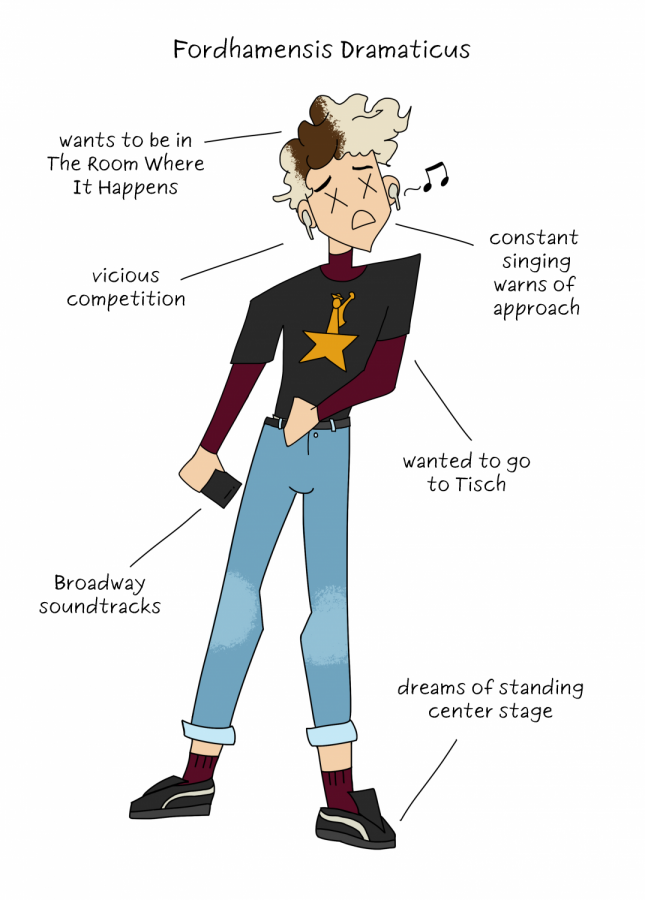A Naturalist’s Guide to Fordham Lincoln Center
August 27, 2019
First, a bit of history.
Fordham University features two distinct biomes, Rose Hill and Lincoln Center. Although at first these two habitats seem to harbor entirely different populations, recent research has revealed that the same species can be found in both locations, though significant behavioral differences are common. This conclusion was drawn after individuals were seen traveling back and forth between both locales for brief periods, freely intermingling with conspecifics at each campus.
However, reports of interbreeding are somewhat rare, possibly indicating that the populations are beginning to diverge. The Rose Hill ecosystem is far larger and more open, allowing for greater biodiversity. Basking behavior, rarely seen at Lincoln Center, is far more common here, and Fordham Jocks (Fordhamensis ramses) are only found on the wide-open practice fields of Rose Hill. Despite being the only local species to inhabit this ecological niche, they are ill-adapted to the wider world and are often outcompeted by other species when they venture outside the fence.
Historical analysis has concluded that the Lincoln Center populations are the result of a small group of Rose Hill individuals that settled in the area. It is theorized that they were cut off from their native habitat during an excursion sometime around 1968 CE, possibly by a traffic jam or D train maintenance. This population bottleneck may have caused the lower biodiversity at Lincoln Center. Some field researchers claimed to have found other isolated pockets of Fordhamensis caused by similar events, but these reports remain unconfirmed.
Returning to Lincoln Center, where our gaze rests, one can observe several distinct species.
The most prevalent group is the Common Liberal Arts Major, scientific name Fordhamensis unprofitabilis. Prolific and diverse, the “common” epithet in the name of this species is well-deserved — it is second only to the city rat in when it comes to population on campus. The sheer number of individuals has led to the formation of several subspecies dedicated to finding a particular niche, but members still freely intermingle. These subspecies include the Bohemian Visual Artisan (Fordhamensis unprofitabilis cryptid), the Chatty Marketeer (Fordhamensis unprofitabilis internis), the Crook-Bodied Politic (Fordhamensis unprofitabilis neuroticus) and the Bly’s English Fool (Fordhamensis unprofitabilis unprofitabilis).
One species that diverged early from the ancestor of the Common Liberal Arts Major is the Gabelli’s Pinstriped MBA (Fordhamensis Gabelli), the males of which can be identified by their khaki legs and business casual appearance. During internship season, they shed their casual study coat for darker, more formal “suit” coloration for use in their courtship displays, known as “interviews.” Females have more colorful displays, and can frequently be seen at coffee holes.
An incredibly rare sight on campus is the Lincolnian Honors Programmite, Fordhamensis Honorabilis. Unlike most species of the genus Fordhamensis, the Programmite is highly adapted to group living and forms close, insular bands with conspecifics of the same age. Members of this species are normally quite shy and elusive creatures, and only move between their numerous communal dens under cover of darkness. Occasionally, Programmites may adopt one or two Common Liberal Arts Majors into their group, provoking many theories as to how the two species could be related.
Fordhamensis dramaticus, the Silver-Tongued Thespian, is the alpha predator of the Fordham ecosystem, prowling the hallways for new recruits and intimidating others through song. Due to high rates of intraspecific competition, few individuals live to adulthood, and fewer still make it to their fourth year. Their colorful plumage is not just for mating purposes, but to warn away anyone who would seek to challenge their dominance. If you see one, your best option is to play dead — in their efforts to outperform you, they, too, will emulate a corpse, allowing you to slip away as they lay trapped and unable to break character.
The gentler cousin of the Silver-Tongued Thespian is the Lesser Ailey Dancer, Fordhamensis cavortus. Although this species is now known to be merely the juvenile form of the Greater Ailey Dancer (Saltator Ailey) found at the Joan Weil Center, it has kept its Fordhamensis classification as it is better understood in the context of the Fordham ecosystem. Their plumage is much more drab than the Silver-Tongued Thespian, a consequence of their significantly more active lifestyle. They can often be seen striding through the halls, hurried yet graceful, as they move to the beat of their own busy schedules.
The most endangered species at Fordham Lincoln Center is Fordhamensis profitabilis, better known as the Hunchback of Lame Notre Dame. Members of this species trek long distances for either internships or labs at Rose Hill and frequently boast to other groups that they are the only F. profitabilis that they know. This brazen behavior means they are preyed upon by nearly every other species on campus, who hunt them for sport due to jealousy of their future career prospects. As such, Fordhamensis profitabilis limits their Fordham Lincoln Center appearances to studying at Quinn Library or crying in the stairwell. The extreme evolutionary pressure on the population has led to the development of several subspecies, including Grey’s MCAT (Fordhamensis profitabilis medicus), the Lesser Caffeinated Litigator (Fordhamensis profitabililis nefarius) and the Reticulated Science Major (Fordhamensis profitabilis loseribilis), though fossil evidence suggests they might have once been highly successful.












